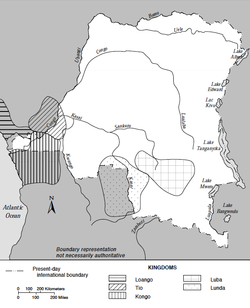Tio Kingdom
This article includes a list of references, related reading, or external links, but its sources remain unclear because it lacks inline citations. (April 2022) |
Tio Kingdom | |||||||
|---|---|---|---|---|---|---|---|
| pre 1506–1880 | |||||||
 The approximate location of Tio Kingdom, showing the Democratic Republic of the Congo in white. | |||||||
| Capital | Monsol | ||||||
| Ethnic groups | Bateke | ||||||
| Makoko | |||||||
| History | |||||||
• Established | pre 1506 | ||||||
• Disestablished | 1880 | ||||||
| |||||||
The Anziku Kingdom, also called the Teke Kingdom, Tyo Kingdom, Tio Kingdom, or Great Makoko, was a West Central African state of modern Republic of Congo, Gabon and Democratic Republic of Congo.
Etymology
[edit]The word Anziku comes from the KiKongo phrase "Anziku Nziku" meaning "to run" referring to inhabitants who leave the interior to protect the border. The term was applied most famously to the Bateke, which is why the state is sometimes called the kingdom of Teke or Tiyo.
History
[edit]Teke oral tradition holds that Mabiala Mantsi, also known as King Mbé, united the Bateke tribes, centralised his governance, and expanded using militaristic and diplomatic skill.[1][better source needed]
In the 15th century, the Kingdom of Kongo's conquests eastward brought it into conflict with the Teke Kingdom which halted their expansion.[2]: 30
In the early 17th century, the Anziku population controlled the copper mines around Kongo's northeast border and may have been there specifically as a buffer. When the Anziku groups consolidated to form their own independent kingdom, Kongo proceeded to take over the mines personally. This process was complete by the 1620s. There was, however, fighting between the two states over the region throughout the 17th century.
The kingdom of Anziku survived well into the 19th century. This is likely in no little part due to its relative isolation from coastal powers. The French, from whom much of our information about Anziku derives, convinced the kingdom to become a vassal in return for protection. In 1880, the last independent Anziku king Makoko signed a treaty of vassalage with the French naval officer Pierre Savorgnan de Brazza. The kingdom continued under French protection producing a line of kings that continues to this very day.
Geography
[edit]The kingdom was centered on the Congo River around the Pool Malebo. It also controlled land directly north of that placing closer to the interior of its better known contemporaries such as Kongo and Loango. The BaTeke people, who dominated the kingdom, lived on the plateaus of the region from early times. By 1600, Anziku controlled the lower Congo River and extended northwest to the upper Kouilou-Niari basin.
Government
[edit]The kingdom was ruled by a king called a makoko. This led to the state sometimes being labeled "Great Makoko" on European maps. The capital was called Monsol, located slightly north of Stanley Pool. According to the account of one of the few visitors, the makoko ruled over 13 vassal kings.
Economy
[edit]The Anziku kingdom manufactured and sold fabrics made of leaves, which doubled as currency throughout the region. Their position closer to the interior also made ivory accessible. Along with these products, the Anziku sold slaves which they brought to the coast in return for cowries, salt, silk, linen and glass. The area was also rich in metals particularly copper. This led to conflict between Anziku and its southern neighbor Kongo.
Customs
[edit]The BaTeke and other Anziku groups practiced facial scarification. The people were also notable for elaborate dress and hairstyles including ornamented braids. Commoners of both sexes usually went bare chested, but those with money were covered "head to foot" according to European accounts. Nobles wore robes of silk imported from the coast.
Warfare
[edit]The Anzikus may have begun as a military class protecting the BaKongo border. They were famed as excellent warriors and courageous. They specialized in archery with poison arrows. In close combat, they relied on battle axes. No mention of shields occurs as with most peoples in this region with the exception of Kongo.
Fiction
[edit]At times the Anzikus have been described, probably falsely, as cannibals in the works of European authors. It was claimed that whole markets were dedicated to the sale of human flesh for consumption. A notable example is H. P. Lovecraft's The Picture in the House.
Bibliography
[edit]- Volavkova, Zdenka. Crown and Ritual: The Royal Insignia of Ngoyo. University of Toronto Publishing. 1998
- Malte-Brun, Conrad. Universal Geography: Or, A Description of the World, on a New Plan, According to the Great Natural Divisions of the World. J. Laval, 1829.
- Vansina, Jan (1973). The Tio Kingdom of the Middle Congo, 1880-1892. London: Oxford University Press for the International African Institute. ISBN 9780429941399.
References
[edit]- ^ "▷ Who is the founder of the Téké kingdom? |". visitfranceguide.com (in Spanish). 2024-09-16. Retrieved 2024-10-23.
- ^ Thornton, John K. (2020), "The Development of States in West Central Africa to 1540", A History of West Central Africa to 1850, New Approaches to African History, Cambridge: Cambridge University Press, pp. 16–55, ISBN 978-1-107-56593-7, retrieved 2024-09-21